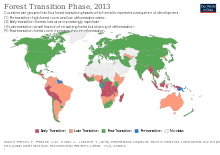
Deforestation or forest clearance is the removal of a forest or stand of trees from land that is then converted to non-forest use. Deforestation can involve conversion of forest land to farms, ranches, or urban use. The most concentrated deforestation occurs in tropical rainforests. About 31% of Earth's land surface is covered by forests at present. This is one-third less than the forest cover before the expansion of agriculture, with half of that loss occurring in the last century. Between 15 million to 18 million hectares of forest, an area the size of Bangladesh, are destroyed every year. On average 2,400 trees are cut down each minute.

Reforestation is the natural or intentional restocking of existing forests and woodlands (forestation) that have been depleted, usually through deforestation but also after clearcutting. Two important purposes of reforestation programs are for harvesting of wood or for climate change mitigation purposes.

Resource depletion is the consumption of a resource faster than it can be replenished. Natural resources are commonly divided between renewable resources and non-renewable resources. Use of either of these forms of resources beyond their rate of replacement is considered to be resource depletion. The value of a resource is a direct result of its availability in nature and the cost of extracting the resource, the more a resource is depleted the more the value of the resource increases. There are several types of resource depletion, the most known being: Aquifer depletion, deforestation, mining for fossil fuels and minerals, pollution or contamination of resources, slash-and-burn agricultural practices, soil erosion, and overconsumption, excessive or unnecessary use of resources.

Socioeconomics is the social science that studies how economic activity affects and is shaped by social processes. In general it analyzes how modern societies progress, stagnate, or regress because of their local or regional economy, or the global economy.

Forestation is a vital ecological process where forests are established and grown through afforestation and reforestation efforts. Afforestation involves planting trees on previously non-forested lands, while reforestation focuses on replanting trees in areas that were once deforested. This process plays an important role in restoring degraded forests, enhancing ecosystems, promoting carbon sequestration, and biodiversity conservation.
An environmental factor, ecological factor or eco factor is any factor, abiotic or biotic, that influences living organisms. Abiotic factors include ambient temperature, amount of sunlight, air, soil, water and pH of the water soil in which an organism lives. Biotic factors would include the availability of food organisms and the presence of biological specificity, competitors, predators, and parasites.
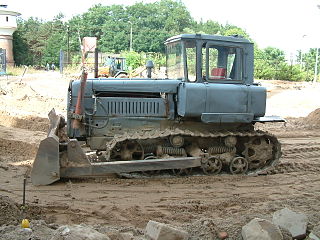
Land development is the alteration of landscape in any number of ways such as:
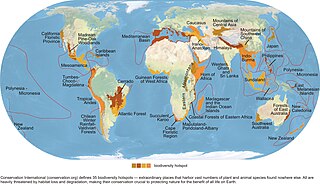
Habitat destruction is the process by which a natural habitat becomes incapable of supporting its native species. The organisms that previously inhabited the site are displaced or dead, thereby reducing biodiversity and species abundance. Habitat destruction is the leading cause of biodiversity loss. Fragmentation and loss of habitat have become one of the most important topics of research in ecology as they are major threats to the survival of endangered species.

Deforestation in Thailand refers to the conversion of its forested land to other uses. Deforestation numbers are inexact due to the scope of the issue. According to the Royal Forest Department (RFD) in 2019, Thai forests cover 31.6% of Thailand's landmass. The department claims that forest coverage grew by 330,000 rai in 2018, an area equivalent in size to the island of Phuket. A year earlier, an academic claimed that, since 2016, forested area has declined by 18,000 rai, a significant improvement over the period 2008–2013, when a forested million rai were lost each year. In 1975, the government set a goal of 40% forest coverage—25% natural forest and 15% commercial forest—within 20 years. To achieve that target in 2018, 27 million rai would have to be afforested.
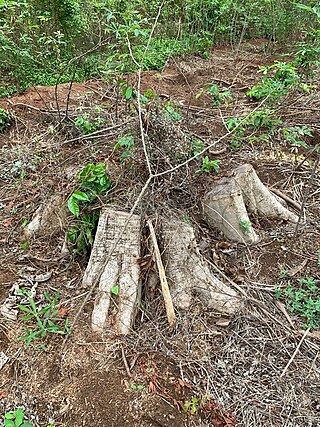
Deforestation in Nigeria refers to the extensive and rapid clearing of forests within the borders of Nigeria. This environmental issue has significant impacts on both local and global scales.
According to a 2005 report conducted by the Food and Agriculture Organization of the United Nations (FAO), Vietnam has the second highest rate of deforestation of primary forests in the world, second only to Nigeria.

Malaysia faces several environmental issues. Malaysia's environment possesses megadiverse biological diversity, with globally significant endemism and biodiversity, but is threatened by several issues. Deforestation is a major issue in the country that has led to many species becoming threatened with extinction. As a major economic sector, palm oil production has had a substantial environmental impact. Air pollution is also a major issue, with the country one of the most affected countries by seasonal Southeast Asian haze. The country is also affected by climate change.

Rates and causes of deforestation vary from region to region around the world. In 2009, two-thirds of the world's forests were located in just 10 countries: Russia, Brazil, Canada, the United States, China, Australia, the Democratic Republic of the Congo, Indonesia, India, and Peru.

Deforestation in Madagascar is an ongoing environmental issue. Deforestation creates agricultural or pastoral land but can also result in desertification, water resource degradation, biodiversity erosion and habitat loss, and soil loss.

Central American countries have experienced cycles of deforestation and reforestation since the decline of Maya civilization, influenced by many factors such as population growth, agriculture, narcotic distribution and illegal practices. From 2001 to 2010, 5,376 square kilometres (2,076 sq mi) of forest were lost in the region. In 2010 Belize had 63% of remaining forest cover, Costa Rica 46%, Panama 45%, Honduras 41%, Guatemala 37%, Nicaragua 29%, and El Salvador 21%. Most of the loss occurred in the moist forest biome, with 12,201 square kilometers. Woody vegetation loss was partially set off by a plus in the coniferous forest biome with 4,730 km2, and at 2,054 km2. Mangroves and deserts contributed only 1% to the loss in forest vegetation. The bulk of the deforestation was located at the Caribbean slopes of Nicaragua with a minus of 8,574 square kilometers of forest lost in the period from 2001 to 2010. The most significant regrowth of 3,050 km2 of forest was seen in the coniferous woody vegetation of Honduras.

Forest restoration is defined as “actions to re-instate ecological processes, which accelerate recovery of forest structure, ecological functioning and biodiversity levels towards those typical of climax forest” i.e. the end-stage of natural forest succession. Climax forests are relatively stable ecosystems that have developed the maximum biomass, structural complexity and species diversity that are possible within the limits imposed by climate and soil and without continued disturbance from humans. Climax forest is therefore the target ecosystem, which defines the ultimate aim of forest restoration. Since climate is a major factor that determines climax forest composition, global climate change may result in changing restoration aims. Additionally, the potential impacts of climate change on restoration goals must be taken into account, as changes in temperature and precipitation patterns may alter the composition and distribution of climax forests.
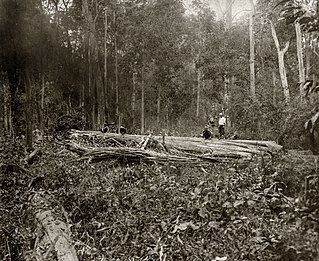
According to a report by the Food and Agriculture Organization of the United Nations, Myanmar lost 19%, or 7,445,000 hectares, of forest between 1990 and 2010. With forest covering as much as 70% of Burma at the time of independence, there were only slightly more than 48% forest cover left as of 2014. The deforestation rate of Myanmar has declined from 0.95% per year in the years 1990–2010 to about 0.3% per year and deforestation in Myanmar is now less than other countries of the region such as Indonesia or Vietnam, but still remains an important environmental issue. Three main factors contribute to continued deforestation: unsustainable and illegal logging, unresolved land rights and land disputes and extensive agricultural development.

Deforestation is a primary contributor to climate change, and climate change affects forests. Land use changes, especially in the form of deforestation, are the second largest anthropogenic source of atmospheric carbon dioxide emissions, after fossil fuel combustion. Greenhouse gases are emitted during combustion of forest biomass and decomposition of remaining plant material and soil carbon. Global models and national greenhouse gas inventories give similar results for deforestation emissions. As of 2019, deforestation is responsible for about 11% of global greenhouse gas emissions. Carbon emissions from tropical deforestation are accelerating. Growing forests are a carbon sink with additional potential to mitigate the effects of climate change. Some of the effects of climate change, such as more wildfires, insect outbreaks, invasive species, and storms are factors that increase deforestation.

Land change science refers to the interdisciplinary study of changes in climate, land use, and land cover. Land change science specifically seeks to evaluate patterns, processes, and consequences in changes in land use and cover over time. The purpose of land change science is to contribute to existing knowledge of climate change and to the development of sustainable resource management and land use policy. The field is informed by a number of related disciplines, such as remote sensing, landscape ecology, and political ecology, and uses a broad range of methods to evaluate the patterns and processes that underlie land cover change. Land change science addresses land use as a coupled human-environment system to understand the impacts of interconnected environmental and social issues, including deforestation and urbanization.

Telecoupling is a strategy that comprehensively analyzes both the socioeconomic and environmental impacts over long distances. The concept of telecoupling is a logical extension of research on coupled human and natural systems, in which interactions occur within particular geographic locations. The telecoupling framework derives from the understanding that all land systems are connected through coupled human and natural systems, and these that social, ecological, and economic impacts are the result. The term telecoupling was first coined by Jianguo Liu as an evolution of the term teleconnection. While teleconnection makes reference to atmospheric sciences only, telecoupling references the integration of multiple scientific disciplines including social science, environmental science, natural science, and systems science. The integration of these dynamic fields of science is what allows the telecoupling framework to comprehensively analyze distal connections that have been previously understudied and unacknowledged.

